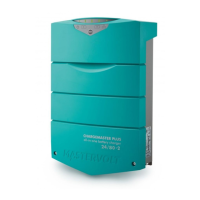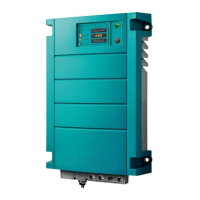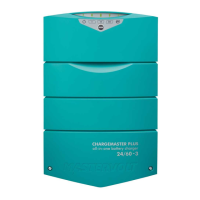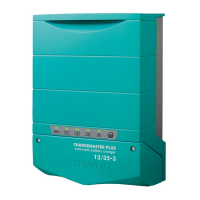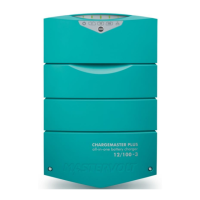INSTALLATION
10 August 2009 / Chargemaster1 12/35-3, 12/50-3, 24/20-3 & 24/30-3 / EN
4 INSTALLATION
During installation and commissioning of the
Chargemaster, the important safety instructions are
applicable at all times. See chapter 2 of this manual.
4.1 UNPACKING
In addition to the Chargemaster the delivery includes:
• a mounting bracket to mount the chargemaster to a
wall;
• a battery temperature sensor;
• a MasterBus terminating device (see chapter 6);
• the installation manual
After unpacking, check the contents for possible damage.
If in doubt, contact your supplier.
Check from the identification label (see section 1.4)
whether the battery voltage is the same as the nominal
output voltage of the Chargemaster (e.g. 24V battery set
for a 24V battery charger).
4.2 ENVIRONMENT
Obey the following stipulations during installation:
• The Chargemaster is designed for indoor use only.
• Ambient temperature: 0 ... 60°C / 32°F … 140°F;
(power derating above 40°C / 104 °F to decrease the
internal heat sink temperature).
• Humidity: 0-95% non condensing.
• Mount the Chargemaster vertically, with the connecting
cables downwards.
• Make sure that the hot air that is developed during
operation can be discharged. The Chargemaster must
be mounted in such a way that obstruction of the
airflow through the ventilation openings will be
prevented.
• No objects must be located within a distance of 10 cm /
4 inch around the Chargemaster.
• Do not locate the Chargemaster in the same
compartment as the batteries.
• Do not install the Chargemaster straight above the
batteries because of possible corrosive sulphur fumes.
4.3 WIRING AND BATTERIES
WARNING!
The wire and fuse sizes stated in this manual
are given as example only. Prescribed wire
and fuse sizes may be different due to local
applicable regulations and standards.
4.3.1 AC wiring
For a safe installation the correct wire cross section must
be applied. Don’t use a cross section that is smaller than
indicated. See table below to select the appropriate cross
section for the AC wiring (up to 2m / 6ft length):
AC Current Minimum cross section:
in mm² AWG
4-6 A 1.0 mm² 17
6-12 A 1.5 mm² 15
Connection of AC-wiring and recommended wire colours
• 230V/50Hz installations:
Wire color Meaning Connect to:
Brown or black Phase L1
Blue Neutral N
Green/Yellow Earth PE / GND
• 120V/60Hz installations (single phase):
Wire color Meaning Connect to:
Black Hot or Line L1
White Neutral N
Green Ground PE / GND
4.3.2 DC wiring
Keep in mind that high current will pass through the DC
wiring. Keep the cable length as short as possible, this will
keep the system efficiency as high as possible. The
recommended minimum cross section of the battery
cables for output 1, 2 and 3 is:
DC Cable cross section: Model
Chargemaster
<2m / 6ft 2-5m / 6ft
12/35-3 16mm² / 4AWG 25mm² / 2AWG
12/50-3 25mm² / 2AWG 35mm² / 1AWG
24/20-3 10mm² / 6AWG 16mm² / 4AWG
24/30-3 16mm² / 4AWG 25mm² / 2AWG
Use ring terminals on the ends of the wires. The terminals
must be crimped with a proper crimping tool. Use the
following wire colours for DC wiring colour or at least
different colours to make a clear distinction between the
positive and negative wire from the battery:
Wire color Meaning Connect to:
Red Positive + (POS)
Black Negative – (NEG)
Lay the positive and negative cables next to each other to
limit the electro magnetic field around the cables. The
negative cable should be connected directly to the

